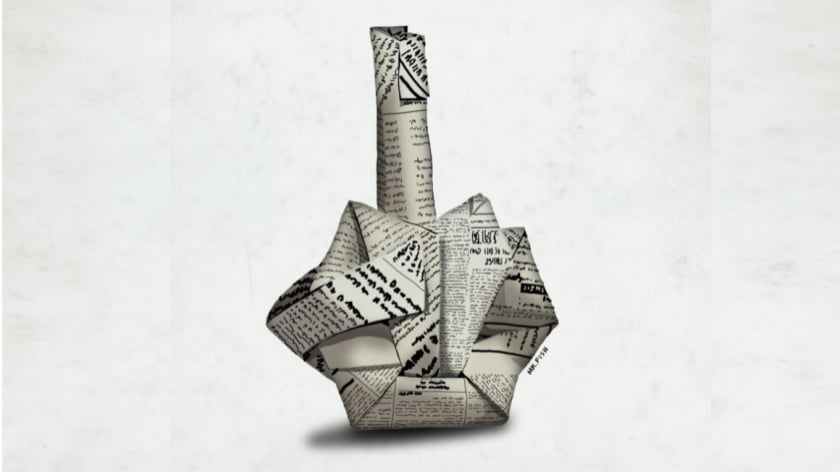The Mass Media is Poisoning Us with Hate
In “Manufacturing Consent: The Political Economy of the Mass Media,” published in 1988, Edward S. Herman and Noam Chomsky exposed the techniques that the commercial media used to promote and defend the economic, social and political agendas of the ruling elites. These techniques included portraying victims as either worthy or unworthy of sympathy. A Catholic priest such as Jerzy Popiełuszko, for example, murdered by the communist regime in Poland in 1984, was deified, but four Catholic missionaries who were raped and murdered in 1980 in El Salvador by U.S.-backed death squads were slandered as fellow travelers of the “Marxist” rebel movement. The techniques also included both narrowing the debate in a way that buttressed the elite consensus and intentionally failing to challenge the intentions of the ruling elites or the actual structures of power.
“Manufacturing Consent” was published on the eve of three revolutions that have dramatically transformed the news industry: the rise of right-wing radio and Fox-style TV news that abandon the media’s faux objectivity, the introduction of 24-hour cable news stations, and the creation of internet platforms—owned by a handful of corporations—that control the distribution of news and information and mine our personal data on behalf of advertisers, political campaigns and the government. The sins of the old media, bad though they were, are nothing compared with the sins of the new media. Mass media has degenerated into not only a purveyor of gossip, conspiracy theories and salacious entertainment but, most ominously, a purveyor of hate. Matt Taibbi, the author of “Hate Inc.: How, and Why, the Media Makes Us Hate One Another,” has dissected modern media platforms in much the same way that Herman and Chomsky did the old media.
The new media, Taibbi points out, still manufactures consent, but it does so by setting group against group, a consumer version of what George Orwell in his novel “1984” called the “Two Minutes Hate.” Our opinions and prejudices are skillfully catered to and reinforced, with the aid of a detailed digital analysis of our proclivities and habits, and then sold back to us. The result, Taibbi writes, is “packaged anger just for you.” The public is unable to speak across the manufactured divide. It is mesmerized by the fake dissent of the culture wars and competing conspiracy theories. Politics, under the assault, has atrophied into a tawdry reality show centered on political personalities. Civic discourse is defined by invective and insulting remarks on the internet. Power, meanwhile, is left unexamined and unchallenged. The result is political impotence among the populace. The moral swamp is not only a fertile place for demagogues such as Donald Trump—a creation of this media burlesque—but channels misplaced rage, intolerance and animosity toward those defined as internal enemies.
The old media sold itself as objective, although as Taibbi points out, this was more a reflection of tone rather than content. This vaunted objectivity and impartiality was, at its core, an element of a commercial tactic designed to reach the largest numbers of viewers or readers.
“Objectivity was when I was told I couldn’t write with voice,” Taibbi told me when I interviewed him on my television show, “On Contact.” [Part one of the interview; part two.] “I couldn’t write with a point of view. Objectivity was to write in a dull, flat, third-person perspective. Don’t express yourself. Don’t be too colorful. This actually was, if you pick up The New York Times today, that same writing style. The original idea behind it is you didn’t want to turn off people on the start because they’re trying to reach the widest possible audience. This also infected radio, television. That’s why you have this Tom Brokaw, Dan Rather-style delivery, which was monotonal, flat, unopinionated. A lot of people thought this was some kind of an ethical decision that news organizations were making. In fact, what they were trying to do is reach the greatest number of people to sell the greatest number of ads. That’s how we developed that idea.”
The old media rigidly held to the fiction that there were only two kinds of political opinions—those expressed by Democrats and those expressed by Republicans. These two positions swiftly devolved into caricatures on radio and television. The classic example was the show “Crossfire,” in which two antagonists, the stereotypical liberal and the stereotypical conservative, could never agree. The liberal, Taibbi pointed out, “was always cast as the person who couldn’t punch back. He was always in retreat. The conservative was always in attack mode. A personality like Tucker Carlson.” These staged and choreographed confrontations were, in essence, sporting events.
“If you watch a [‘Sunday NFL] Countdown’ you’ll see the sets are designed exactly the same” as that of “Crossfire.” “The anchor on one side. There’s usually four commentators—two that represent each team. They have graphics that tell you what the score is, who is ahead, who is behind. We want people to perceive politics as something they have a rooting interest in. There’s no possibility of any gray area in any of this. Your political identity can’t possibly bleed into any other political identity. You are on one team or another. That’s it. We don’t even acknowledge the existence of people who have different types of ideas. For instance, anti-abortion but also pro-union. Whatever it is. That doesn’t exist in the media.”
The fact that on most big issues the two major political parties are in agreement is ignored. The deregulation of the financial industry, the militarization of police, the explosion in the prison population, deindustrialization, austerity, the endless wars in the Middle East, the bloated military budget, the control of elections and mass media by corporations and the wholesale surveillance of the population by the government all have bipartisan support. For this reason, they are almost never discussed.
“It’s always presented as two parties that are always in disagreement about everything,” Taibbi said, “which is not true.”
“We [members of the press] are not focusing on the timeless, permanent nature of how the system works,” he said. “We don’t think about the central bank. We don’t think about the security state. We don’t think about any of that stuff. We focus on personalities. Donald Trump versus Alexandria Ocasio-Cortez. That simplifies everything and allows us to not look at the bigger picture.”
Once the old media model imploded with the arrival of 24-hour news networks, Fox-style news and the internet, the monopoly of a few dominant newspapers and networks ended. In the new setting, media organizations tailor their content to focus on specific demographics.
“MSNBC, which has gone through some interesting changes over the years, markets itself as a left-leaning network,” Taibbi said. “But it was so intensely pro-war in 2002 that it had to uninvite Jesse Ventura and Phil Donahue from the network. This latest thing was ‘Russiagate’ and the constant hyping of the narrative ‘If you watch, you might learn any minute that we, along with Robert Mueller, are going to take down the president.’ ”
The media model not only sets demographic against demographic, it mutes and destroys investigations into corporate systems of oppression and genuine dissent.
“You don’t have to make the news up for these people,” Taibbi said of the process of carving up the public. “You can just pick stories that they’re going to like. You start feeding them content that is going to ratify their belief systems. Fox did it first. They did it well. They started to make money. They were No. 1 for a long time. But this started to bleed into the rest of the business. Pretty soon, everybody was doing the same thing. It didn’t matter whether you were the food channel tailoring content for people who liked food or MSNBC who tailored content for people who leaned in a certain political direction, you were giving people stuff they wanted to hear.”
“Previously, you were looking at the illusion of debate,” Taibbi said of the old media model. “You would see people arguing on ‘Crossfire.’ On the op-ed pages, there were people who disagreed with each other. Now, most people’s news consumption experience is tailored entirely to their preferences. … If you’re only reading media that tailor to your particular belief system you’re not being exposed to other ideas. It’s going to be progressively more vituperative.”
“One of the first stories that taught the news business you can actually sell anger as a product was the [Monica] Lewinsky scandal,” Taibbi said.
MSNBC built its brand and its audience by relentlessly warning that the presidency of Bill Clinton was in mortal peril during the Lewinsky investigation. It repeated this formula by spending two years hyping the story of supposed Russian collusion with the Trump administration.
“What they were trying to do was basically create the impression that [a new] ‘Watergate was going on, you better tune in because at any moment this could all go kaput,’ ” Taibbi said of the Lewinsky scandal. “They got an enormous market share. Fox added a twist to it. Fox took the same concept and openly villainized the characters. They decided to make Bill and Hillary Clinton into caricatures and cartoon figures, aging hippies. They kept running clip after clip of Hillary Clinton talking about how she didn’t bake cookies. They knew their audience was going to react to all these images in a certain way. They sold people stories that make them angry. They told them, ‘If you keep tuning in, somehow you are a part of the process. You are a part of this ongoing prosecution of this culture enemy that we’re showing you. … We tell you about somebody you don’t like. We keep telling you about it over and over to dominate the ratings.’ ”
The result, Taibbi argues, is a marketing strategy that fosters addictive and aggressive behavior. The more the habits of readers and viewers on the internet and electronic devices are tracked, the more the addiction and aggression are fed.
“This creates more than just pockets of political rancor,” he went on. “It creates masses of media consumers who have been trained to only see in one direction, as if they have been pulled through history on a railroad track, with heads fastened in blinders, looking only one way. … Even without the vitriolic content, just the process of surfing and consuming the news has a lot of the same qualities as other addictions—like smoking cigarettes or taking drugs. People get addicted to the feel of their phones. They get addicted to the process of turning on screens. You especially get addicted to the idea that you’re going to turn on a news program or read an article and it’s going to tell you something that is going to anger you even more than you were yesterday.”
The template for news, Taibbi writes, is professional wrestling.
“Wrestling was a commercial formula that they figured out worked incredibly well,” Taibbi said of the corporate owners of news outlets. “There was a simplified morality play where there was a good guy, who was called the baby face, and a bad guy they called the heel. They relentlessly hyped the bad guy. The heel was more important in wrestling and more popular than the face. The amount of tickets they can sell is a direct correlation to how much people hate the bad guy. You have to have a hateable heel in order to make the formula work. This is how news works.”
Reporters, Taibbi writes in his book, “now regularly do the outraged hero, finger-pointing routine whenever they are within a mile of Trump. Jim Acosta’s confrontations with the president, for instance, seemed pulled straight from WWE [World Wrestling Entertainment] outtakes. Trump’s whole presidency has turned into a heel/hero promotion with Bob Mueller in the face role.”
“Trump fits like a glove into the commercial formula of all of this,” Taibbi said in the interview. “That’s what’s fascinating about it. He actually makes more money for the MSNBC, CNN, Washington Post, New York Times side than he does for Fox and the Daily Caller. He’s a cartoon character who is a perfect heel. You have an utterly simplified political landscape. There are only two ways to be. You are either for this incredibly noxious figure or you are against him.”
But, Taibbi notes, there is a diminishing return as with any addiction.
“You always have to constantly increase the level of the rhetoric in order to get people to keep coming back,” he said. “You can’t be narrowly ‘incompetent’ or ‘corrupt.’ Sooner or later, you have to get to the point where you’re saying ‘demagogues,’ ‘authoritarians,’ ‘dictators.’ Finally, as Glenn Beck discovered, you have to start calling them Hitler. Beck got to the point where he was simultaneously calling people Hitler and Stalin. It wasn’t enough just to be Hitler.”
“If you are defining somebody else as that bad, then everything is permissible,” he said. “We saw this with Russiagate. The same sort of liberal commentators who, ages ago, would have been very concerned about things such as the collapse of attorney-client privilege, or the FISA program, any of that stuff. They don’t care about it anymore. They just want to get the person.”
The shaping of the public into antagonistic tribes works commercially. It works politically. But it is a recipe for social disintegration. I watched competing ethnic groups in the former Yugoslavia seize rival mass media outlets and use them to spew vitriol and hate against the ethnic group they demonized. The poisonous images and rhetoric that were pumped out month after month in Yugoslavia led to a savage fratricide.
The United States is already plagued by an epidemic of mass shootings, death threats against critics of Trump, including Rep. Ilhan Omar, and aborted assassination attempts, including a Trump supporter’s mailing of pipe bombs last year to prominent Democrats and CNN, an effort to decapitate the hierarchy of the Democratic Party, as well as terrorize the media outlet that is the party’s principal propaganda arm.
“If you’re constantly winding up audiences and telling them that all of their troubles are a result of this other group that is literally Hitler, that they’re literally Nazis, they’re literally Stalin, sooner or later some people are going to start picking up weapons and do something crazy,” Taibbi said. “This is why people are correctly upset about Fox News. But they should also be concerned about other forms of media. The formula is similar across the board.”
“Our system of bubble economics is going to produce some kind of a catastrophe at some point,” Taibbi, the author of one of the finest books on the 2008 financial crash, “Griftopia,” concluded. “At which point, if you tell people often enough that their next-door neighbor is literally in the league with Nazis or terrorists or whatever it is—of course Fox pioneered this, going back to the Iraq War, when we were told liberals were terrorist supporters—sooner or later, there’s going to be violence. The inability of society to agree on a common set of facts means the media has failed already. It means we’re just not reaching people. [In this atmosphere] we will never be able to work things out in a civil way.”
By Chris Hedges and Mr. Fish
Source:







